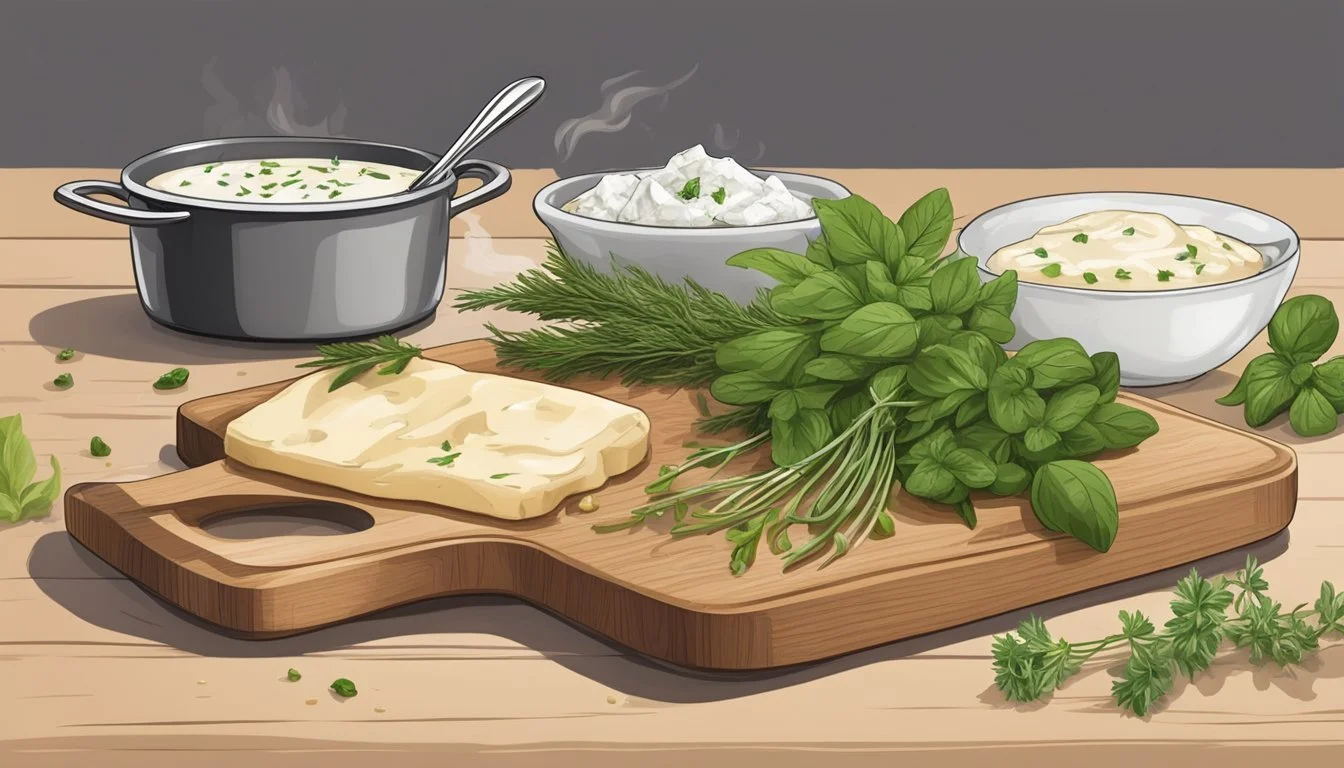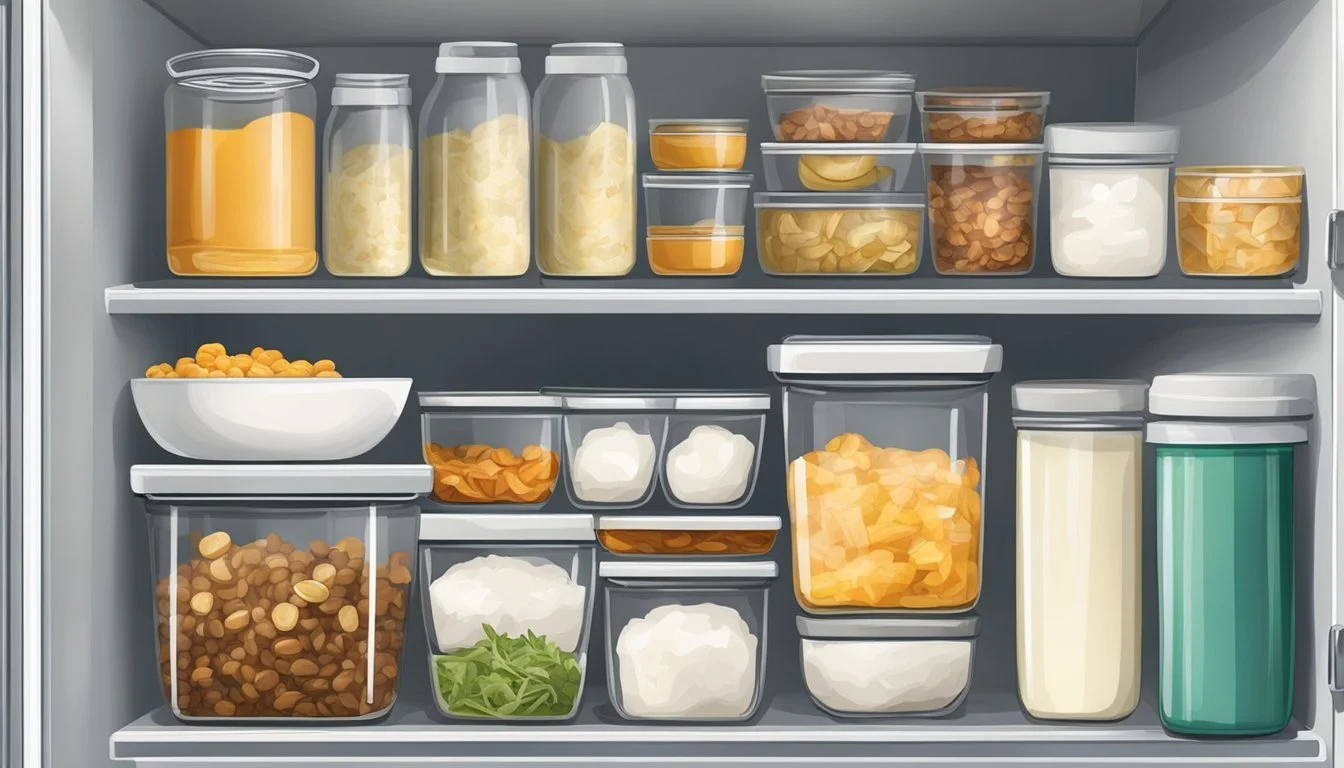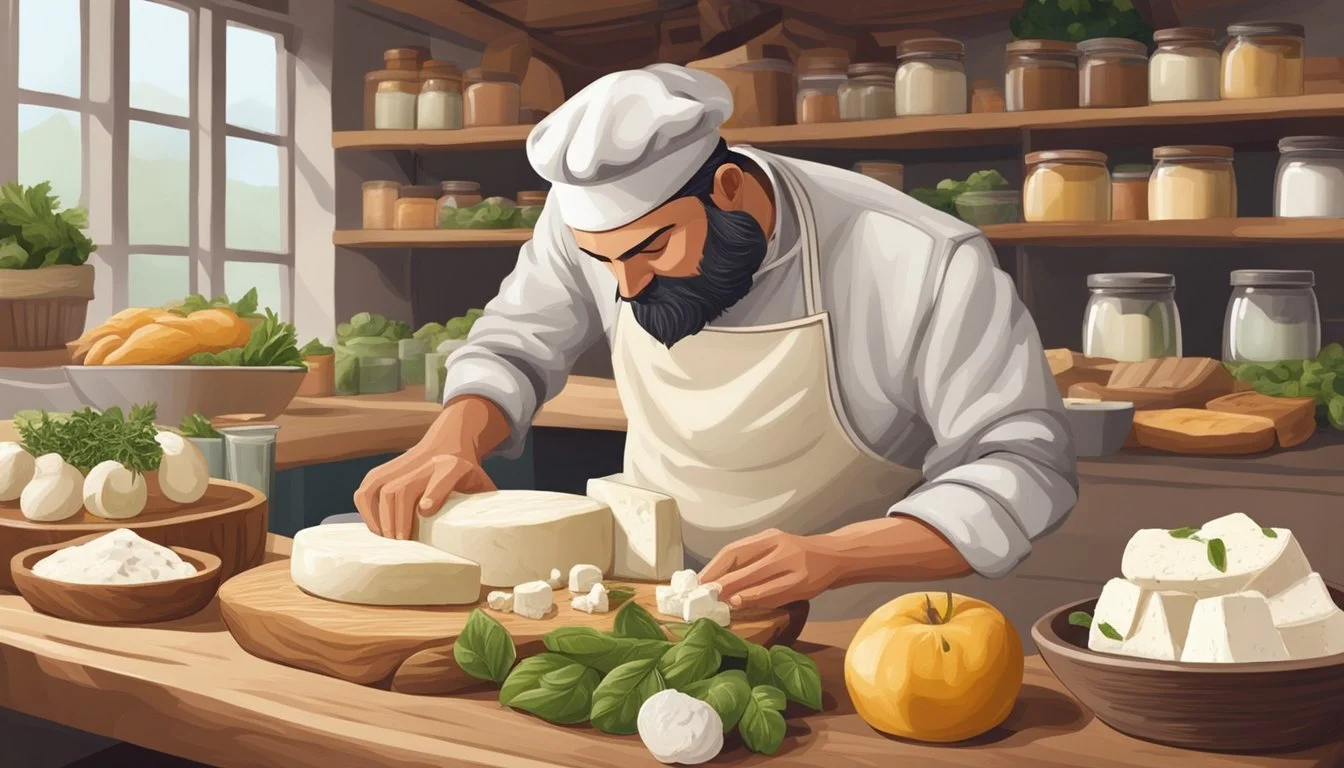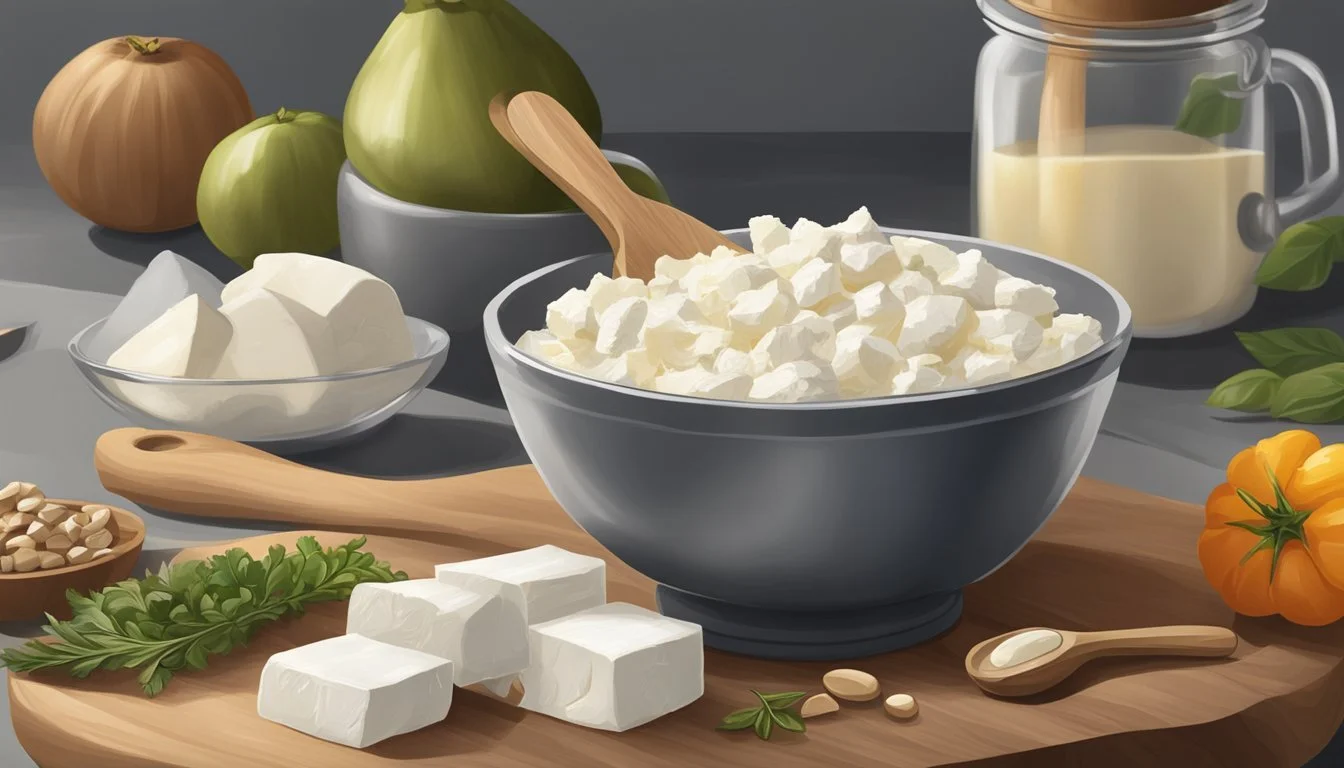How to Cook with Goat Cheese for Creamy Textures
A Guide to Rich and Smooth Dishes
Cooking with goat cheese is an excellent way to add a creamy texture and a unique tangy flavor to a variety of dishes. Known for its soft and spreadable consistency, goat cheese melts beautifully, which makes it a versatile ingredient in many recipes, including easy pasta dishes. It can be gently melted into warm pasta to create a rich and creamy sauce that compliments the delicate nature of pasta. The mild yet distinct taste of goat cheese (What wine goes well with cheese?) pairs well with a range of ingredients, offering a sophisticated twist to simple meals.
Incorporating goat cheese into cooking doesn't require complex techniques. Whether it's mixed into sauces, whipped for a lighter consistency, or crumbled as a flavorful topping, goat cheese enhances the overall feel and taste of a dish. For an effortless pasta recipe, goat cheese can be combined with ingredients like garlic, herbs, and a touch of lemon to balance its richness. This simplicity is perfect for quick weeknight dinners or when aiming to impress guests with minimal effort.
Moreover, goat cheese is not only about adding indulgence to dishes but also about embracing a healthier alternative. It carries fewer calories and is generally easier to digest than cheese made from cow's milk. Its nutritional value, which includes essential vitamins and minerals, further justifies its use in cooking for those looking to create satisfying yet nourishing meals. The cheese's ability to blend into creamy textures makes it a go-to choice for elevating a humble pasta dish to a memorable culinary experience.
Understanding Goat Cheese
Goat cheese, known for its distinctive tang and creamy texture, is a versatile ingredient in the culinary world. It is made from goat's milk and can range from soft and spreadable to semi-hard in consistency. The cheese's natural creaminess lends a luxurious mouthfeel to dishes, without the heaviness often associated with cheese made from cow's milk.
Types of Goat Cheese:
Soft: Spreadable and often found in logs or tubs.
Semi-soft: Slightly firm, often used in slices or crumbles.
Semi-hard: Firm texture, suitable for grating or slicing.
The tang of goat cheese is a result of the specific fermentation process used to make it. This tanginess can cut through the richness of creamy dishes, adding a layer of complexity to the flavor profile. Goat cheese is heralded for its ability to enhance a wide array of recipes, from appetizers (What wine goes well with appetizers?) to desserts.
Goat cheese is generally easier to digest due to the presence of A2 casein, making it a suitable option for those who are sensitive to cow's milk. In terms of nutritional value, it is a source of essential vitamins and minerals, adding a healthful element to the palate.
Nutritional Highlights:
Lower in calories compared to many cow's milk cheeses. (What wine goes well with cow's milk cheeses?)
Rich in important nutrients like Vitamin B, calcium, and iron.
When cooking with goat cheese, it is recommended to let it reach room temperature to maximize its creamy texture when blending into sauces, spreads, and dressings. Whether incorporated into a savory dish or used as a key component in a dessert, goat cheese contributes a unique flavor profile that can elevate the simplest of meals.
Essential Ingredients for Goat Cheese Dishes
When preparing goat cheese dishes for creamy textures, it is crucial to start with high-quality goat cheese and complement it with ingredients that enhance its flavor. Accurate seasoning and the use of top-notch oils, herbs, and spices lead to delightful results.
Selecting Your Goat Cheese
One should carefully choose their goat cheese based on the desired outcome. For spreadable and softer textures, fresh goat cheese, often labeled as "chèvre," is recommended. In contrast, aged goat cheeses (What wine goes well with goat cheeses?) provide a firmer structure suitable for grating or shaving. The selection of goat cheese will drastically influence the creaminess and overall flavor of the dish.
Accompanying Ingredients
To elevate the dish, common accompaniments to goat cheese include:
Vegetables: Sautéed mushrooms add an earthy complexity.
Oils: A drizzle of quality olive oil can enhance the creamy texture.
Dairy: Adding parmesan lends a savory edge and additional richness.
Acids: A splash of balsamic vinegar can cut through the richness with its acidity.
Ingredients should be fresh and prepared meticulously to ensure the right balance with the distinct tang of goat cheese.
Seasonings and Spices
Seasonings play a pivotal role in harmonizing the dish. Essential flavor builders include:
Garlic: Fresh minced garlic imparts a pungent kick.
Herbs: Fresh basil brightens, while dried oregano adds depth.
Spices: A pinch of red pepper flakes introduces subtle heat.
Salt: A little goes a long way to bring out the natural flavors of the cheese and accompaniments.
One must season thoughtfully to create a dish where goat cheese is the star complemented by a chorus of flavors.
Preparation Techniques
When cooking with goat cheese, the objective is often to achieve a creamy texture that enriches dishes from pasta to dips. Understanding the characteristics of goat cheese and the methods to enhance its creaminess is key to successful preparation.
Working with Goat Cheese
Goat cheese, due to its inherent creamy texture, lends itself well to a variety of dishes where smoothness is desired. One must handle it properly to maintain its qualities. For creamy goat cheese pasta or similar dishes, it's beneficial to let the cheese come to room temperature before incorporating it into the recipe. This ensures that it melts evenly and integrates seamlessly. When crumbling goat cheese for salads or as a topping, do so gently with a fork or between fingers to maintain the delicate texture.
Preparing Goat Cheese Description Crumbling Gently break apart for toppings or to mix into salads. Melting Allow cheese to reach room temperature for smooth integration into sauces. Spreading Use at room temperature for even, creamy application in sandwiches or on crackers.
Enhancing Creaminess
To maximize the creaminess of goat cheese, especially in sauces or dips, one can blend it with ingredients that complement its consistency. Acidic components like lemon juice can brighten the flavor while contributing to a smoother texture. For a dish like creamy goat cheese pasta, incorporating liquids such as milk, cream, or pasta water can adjust the consistency to the desired level of creaminess.
Technique Purpose Blending Combine with liquids or other soft cheeses in a food processor for a uniform, creamy dip. Simmering Gently cook with tomatoes or creams to create a rich, velvety sauce. Whipping Whip with herbs and garlic for a fluffy, spreadable consistency.
Adding warmth gradually to goat cheese-based sauces is crucial, as high heat can cause separation. Gentle heating preserves the creamy quality while allowing the goat cheese to melt smoothly into the other ingredients.
Recipes Featuring Goat Cheese
Goat cheese is a versatile ingredient that can transform simple dishes into rich and creamy culinary experiences. Its tangy flavor and smooth consistency make it an excellent cheese for various recipes, from main courses to appetizers.
Goat Cheese Pasta Variations
One can use goat cheese to create a luscious pasta sauce that perfectly coats the pasta. A popular dish is penne pasta with a tomato and goat cheese sauce. The tomato provides acidity and brightness, which balances the richness of the goat cheese. Another delightful variation is cheese tortellini topped with goat cheese sauce, where the cheese inside the tortellini complements the creaminess of the sauce. In crafting these dishes, one should slowly melt the goat cheese into a simmering sauce, allowing for a smooth and even texture.
Appetizers and Salads
Goat cheese is often featured in appetizers and salads, where its creaminess offers a contrast to the crisp greens and vinaigrettes. For instance, small disks of goat cheese can be lightly toasted and placed atop a salad, adding a warm, creamy component. As an appetizer, goat cheese pairs well with figs on a pizza or flatbread, blending sweet, savory, and tangy notes in each bite. Ensuring the goat cheese is at room temperature can enhance its spreadability and flavor profile when used atop crusty bread or crackers.
Goat Cheese on Breakfast Dishes
In breakfast dishes, goat cheese can elevate a simple plate of scrambled eggs to a more sophisticated level. Incorporating crumbles of goat cheese into the eggs as they cook can introduce pockets of melty goodness. Another breakfast option includes creating a spread of softened goat cheese with herbs to layer on toast or bagels, providing a flavorful base for toppings like smoked salmon or roasted vegetables. When using goat cheese in scrambled eggs or spreads, it's important to add it at the end of cooking to avoid overcooking the cheese, ensuring it retains its creamy texture.
Accommodating Dietary Restrictions
When cooking with goat cheese to achieve creamy textures, one must consider guests with dietary restrictions. It is vital to provide delicious gluten-free and vegan alternatives that maintain the integrity of the original dish.
Gluten-Free Alternatives
For gluten-free individuals, one can easily substitute wheat-based products with suitable alternatives. Here are some gluten-free solutions:
Pasta
Gluten-Free Pasta: Opt for pasta made from rice, corn, or quinoa.
Chickpea Pasta: Provides a protein-packed and healthy alternative with a firm texture.
Bread
Gluten-Free Bread or Crackers: Useful for dips or spreads to maintain a crunchy texture without gluten.
Vegetarian and Vegan Options
To cater to vegetarian and vegan diets, chefs can replace dairy-based goat cheese with alternatives that mimic the creamy texture without animal products.
Vegan Cheese
Vegan Goat Cheese: Made from nuts like cashews or macadamias, cultured to achieve tanginess.
Additional Ingredients
Nutritional Yeast: Adds a cheesy flavor to vegan dishes.
Soft Tofu: When blended, it adds a creamy consistency similar to goat cheese.
Utilizing these alternatives ensures that everyone can enjoy the rich, creamy flavors that goat cheese brings to dishes, regardless of dietary restrictions.
Cooking Tips for Perfect Goat Cheese Dishes
When cooking with goat cheese, chefs often strive for a balance between rich creaminess and complementary flavors. Achieving this involves a methodical approach to seasoning and ingredient selection, wherein each element enhances the dish’s overall profile.
Adding Flavor Layer by Layer
To infuse dishes with depth, one must add flavors incrementally. A chef begins by selecting quality fresh goat cheese; its intrinsic tang is a solid foundation on which to build. They may incorporate simple ingredients such as fresh herbs or spices, strategically layering aromatics to enrich the cheese's natural taste. Here’s a quick guide to enhancing flavor:
Salt and pepper: A pinch of each can heighten the goat cheese's flavors. They're staples in layering taste.
Citrus zest or lemon juice: These can brighten the dish and cut through the richness.
One should consider the cheese's reaction to heat and other ingredients while seasoning to prevent overpowering the subtle notes of the soft goat cheese.
Balancing Textures
Texture is paramount in cuisine; it can elevate the sensory experience of a meal. When incorporating soft goat cheese into hot dishes, chefs often use pasta water to adjust the sauce's consistency, adding starchiness for enhanced silkiness. By doing so, they create a more luxurious mouthfeel without the need for heavy creams. A rule of thumb for balancing textures involves:
Start with crumbled or softened goat cheese for easier integration.
Stir in small amounts of pasta water or milk to achieve the desired creaminess.
Avoid high heat, which can cause separation, resulting in a grainy texture.
By sourcing goat cheese from a local vendor, chefs can ensure its freshness, which is crucial for both flavor and texture. Additionally, keeping the ingredient list to a minimum allows the cheese's nuanced profile to shine, neither diluted nor overshadowed by competing tastes.
Serving and Presentation
When cooking with goat cheese for creamy textures, the final presentation can dramatically enhance the dining experience. Strategies for plating and the choice of beverages can amplify the taste and aesthetic appeal.
Plating and Garnishes
Goat cheese's velvety consistency pairs well with a crisp, fresh base. For a refined presentation, one might layer a smear of goat cheese on a bed of arugula. This not only introduces a peppery flavor but also adds a vibrant green backdrop. Sprinkling a dash of black pepper and basil on top of the cheese provides a colorful contrast and a burst of aroma. A few shavings of parmesan cheese can finish the dish with a salty, umami touch, completing the gastronomic experience. Serving suggestions often include a careful arrangement of the ingredients to maximize visual appeal.
Pairing with Beverages
When selecting beverages to accompany goat cheese dishes, a neutral palate is key. Crisp white wines or even a light-bodied red should harmonize with the goat cheese's tanginess without overpowering it. A Sauvignon Blanc or a young Pinot Noir typically balances well against the creaminess of the cheese. Sparkling water with lemon can serve as a refreshing non-alcoholic option, cleansing the palate between bites to fully enjoy the nuances of the goat cheese's flavor profile.
Storing and Reusing Leftovers
Proper storage of leftover goat cheese is crucial for maintaining its quality and extending its usability. Goat cheese should be kept in the coldest part of the refrigerator, often the vegetable crisper, where temperatures remain cool and stable.
For Soft or Semi-Soft Goat Cheese: Wrap leftovers in parchment paper, then place in a resealable plastic container. This method helps preserve the cheese's moisture and texture, ensuring its freshness for future use.
For Semi-Hard Goat Cheese: First wrap in parchment or wax paper, followed by a layer of aluminum foil or plastic wrap. This protects the cheese from drying out and maintains its creamy consistency.
When reusing goat cheese leftovers, consider these simple ideas:
Frittatas or Quiches:
Whisk eggs with salt and pepper.
Pour over sautéed vegetables in a pan.
Crumble the goat cheese on top before cooking.
Croutons:
Cube day-old bread and toss with olive oil and seasoning.
Spread on a baking sheet and sprinkle with goat cheese.
Bake until golden and crunchy.
Salad Dressings:
Blend goat cheese with ingredients like olive oil, vinegar, or lemon juice for a creamy dressing.
Dips:
Mash ripe avocado and goat cheese together.
Add lemon juice for a creamy and tangy dip.
Always serve goat cheese at room temperature to enjoy its full flavor. Reusing goat cheese in these ways not only reduces food waste but also enhances the taste and texture of many dishes.
Innovative Goat Cheese Incorporations
Goat cheese lends a creamy texture and a tangy flavor to dishes, allowing for unique kitchen experiments and fusion creations. Chefs are exploring beyond traditional uses, incorporating goat cheese into a range of cuisines and combinations.
Using Goat Cheese in Fusion Dishes
In the realm of fusion cuisine, goat cheese's versatile texture makes it a prime candidate for innovative dishes. One such dish is goat cheese pizza, where the cheese melts beautifully, combining with fire-roasted tomatoes and a variety of toppings for a modern twist on a classic. An unconventional yet captivating fusion can be found in Asian cuisine, like incorporating whipped goat cheese into dumplings or spring rolls for a creamy filling.
Example of Fusion Dish:
Pizza Base: Traditional dough or cauliflower crust
Sauce: Vodka sauce with a hint of crush tomatoes or simple olive oil base
Toppings: Fire roasted tomatoes, arugula, balsamic glaze, slivers of baked goat cheese
Experimental Pairings
Adventurous chefs pair goat cheese with unexpected ingredients to create novel culinary experiences. Baked goat cheese can be paired with beets and cranberry for a balance of earthy and tart flavors, serving as an exquisite appetizer. For a sweet twist, one might layer creamy goat cheese with spiced pumpkin in a parfait.
Innovative Pairing Ideas:
Appetizer: Baked goat cheese with roasted beets and a cranberry reduction
Dessert: Whipped goat cheese layered with pumpkin puree and crushed ginger cookies
Another trend within experimental pairings involves the use of pressure cookers, like the Instant Pot, to create dips and spreads. A blend of goat cheese, herbs, and crushed tomatoes can be quickly transformed into a comforting dip, suitable for impromptu gatherings or sophisticated enough for formal parties.
Instant Pot Creation:
Ingredients: Goat cheese, dried basil, crushed tomatoes
Process: Combine and cook under high pressure for a swift, flavorful fusion
Health Benefits of Goat Cheese
Goat cheese is praised for its notable health benefits, which stem from its nutritional content. It is generally lower in calories than cow's cheese, making it a preferred choice for those monitoring their caloric intake.
Nutritional Profile: Loaded with essential vitamins and minerals, goat cheese offers a range of health advantages. It contains:
Vitamin A which supports vision and immune function.
Vitamin K, important for blood clotting and bone metabolism.
Riboflavin (Vitamin B2) aids energy production.
Folate, which is key for DNA synthesis and repair.
Niacin (Vitamin B3), supporting enzyme function and energy production.
Additionally, goat cheese provides valuable minerals like:
Calcium: crucial for bone strength.
Phosphorus: works with calcium to bolster bone health.
Magnesium: a cofactor for many enzymatic reactions in the body.
Iron: essential for the formation of hemoglobin which transports oxygen in the blood.
The presence of heart-healthy fats further enhances the nutritional value of goat cheese, promoting better cardiovascular health.
Digestibility: It is often easier to digest due to its unique protein structure and lower lactose content, making it suitable for those with sensitivities to cow's milk.
Incorporating goat cheese into dishes adds a creamy texture without compromising the health quotient. Chefs and food lovers appreciate its versatility and the added benefit of its wholesome, nutrient-rich profile.
Where to Buy Quality Goat Cheese
When seeking quality goat cheese for cooking, one has the option to source it from both local vendors and supermarkets. Consumers who prioritize artisanal and locally-produced cheese should consider their nearest farmers' markets or specialty food shops. Local vendors often offer handcrafted goat cheeses, providing an opportunity to support regional farmers and artisans.
However, for those looking for convenience and variety, supermarkets can be reliable sources of goat cheese. A noteworthy brand found in many stores is Vermont Creamery, renowned for its flavorful and slightly crumbly goat cheese that is both tangy and creamy. Here are some factors to look for when buying goat cheese:
Location of Production: Opt for cheeses that are produced close to where they are sold, ensuring freshness.
Texture and Flavor: If the goal is creamy textures in cooking, look for softer goat cheeses, which blend well into dishes.
Brand Reputation: Research brands and read reviews to confirm the quality of the cheese before purchasing.
Here is a simple table summarizing the points of purchase:
Source Pros Cons Local Vendors Fresh, artisanal quality Might be more expensive Supermarkets Convenient, variety of choices Not all brands may be artisanal
It is essential to choose a goat cheese that complements the intended dish, balancing flavor and creaminess to achieve the desired culinary result. Whether it is from a local vendor or a well-regarded brand at the supermarket, ensure the goat cheese selected is of the highest quality for the best cooking outcomes.
Quick Weeknight Goat Cheese Meals
Incorporating goat cheese into weeknight dinners is an excellent way to add creamy textures and tangy flavors to simple dishes. Goat cheese melts smoothly, making it a perfect ingredient for quick, comfort meals. Here are some easy dinner ideas that can be whipped up on any busy weeknight.
Creamy Goat Cheese Pasta: One can prepare a luscious pasta sauce with just a few ingredients—goat cheese, garlic, olive oil, and a handful of spinach. Saute the garlic until fragrant, then mix in the spinach until it wilts. Blend in crumbled goat cheese and a splash of pasta water to create a creamy sauce. Toss with your favorite pasta for a meal that's both satisfying and simple.
Ingredients: Pasta, goat cheese, garlic, olive oil, spinach
Prep time: 5 minutes
Cook time: 15 minutes
Baked Goat Cheese Marinara: For a delectable appetizer or a light entree, place goat cheese in a baking dish with marinara sauce. Bake until the cheese is warm and the sauce is bubbling. Serve it with a crusty baguette or over cooked spaghetti squash for a nutritious twist.
Ingredients: Goat cheese, marinara sauce, baguette or spaghetti squash
Prep time: 5 minutes
Cook time: 25 minutes
Goat Cheese Stuffed Chicken: Stuff chicken breasts with goat cheese and herbs, and bake until the chicken is cooked through. The goat cheese adds a creamy texture to every bite and keeps the chicken moist.
Ingredients: Chicken breasts, goat cheese, assorted herbs
Prep time: 10 minutes
Cook time: 25 minutes
Each of these meals emphasizes the use of simple ingredients and straightforward preparation techniques, ensuring that a nutritious and flavorful dinner can be served even when the cook is short on time.
FAQs About Cooking with Goat Cheese
What are the benefits of using goat cheese in cooking?
Goat cheese offers a creamy texture that enhances the mouthfeel of various dishes such as dips, sauces, and spreads.
Its distinct tangy flavor can elevate recipes, and because of its lower lactose content, it can be easier to digest for some individuals.
How can one incorporate goat cheese for creamy textures in recipes?
For creamy dips, blend goat cheese with ripe avocado and lemon juice.
Melt goat cheese into marinara sauce for a rich pasta topping or into soups for added creaminess.
What are the best practices for storing goat cheese?
Cheese Type Storage Method Soft or semi-soft Resealable plastic container Semi-hard Wrapped in parchment or wax paper, then foil or plastic
Store in the vegetable crisper for a cold and stable temperature.
Always bring goat cheese to room temperature before serving.
Are there tips for cooking with goat cheese?
When baking, goat cheese doesn't melt into a liquid but softens, ideal for warm applications.
Avoid overcooking to preserve the cheese's texture and flavor.
Crumble goat cheese over salads for a quick flavor boost.
What are some common questions regarding goat cheese in recipes?
Q: Can you substitute goat cheese for other cheeses?
A: Yes, one can use goat cheese instead of cream cheese or ricotta for a tangier, richer taste.
Q: Does goat cheese work well with sweet dishes?
A: Absolutely, its creamy and tangy notes pair beautifully with fruits and honey.










